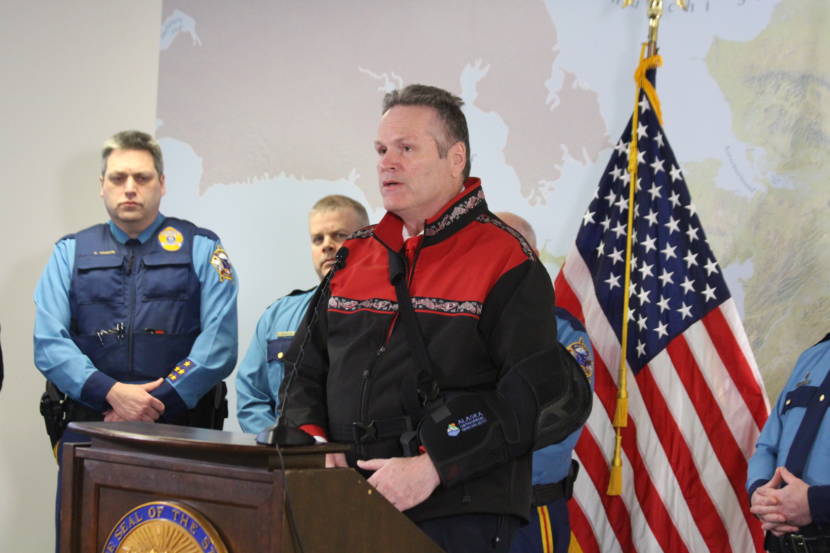
Gov. Mike Dunleavy has proposed a budget for the next fiscal year that would keep state spending similar to the current budget, while increasing the size of permanent fund dividends.
Higher oil prices, lower pension obligations and large amounts of federal funding would allow the state to increase PFDs without spending down state savings for the first time in a decade, according to the Dunleavy administration.
Dunleavy said the state is in a better position than it was when he proposed deep cuts in his first budget.
“We’ve done our best to contain the size of government and refocus where we want to put revenue and funding, especially in the areas of public safety, transportation and the things we’ve lined-out today,” he said a press briefing on Wednesday.
He emphasized that the budget would spend less state money than the budget when he entered office. That doesn’t include the permanent fund dividend.
Dunleavy is proposing a roughly $2,560 permanent fund dividend. That amount is based on what’s known as the 50/50 dividend formula; it’s equal to half of what the state would draw from the permanent fund under a 2018 state law. It is the first of Dunleavy’s budgets that doesn’t include a PFD under the formula in a 1982 law, which is projected to be roughly $4,200.
Dunleavy repeated his call to amend the constitution to include the PFD.
“We’re having a tough time getting the Legislature to agree,” he said. “Nonetheless, we believe that most Alaskans would feel that a 50/50 is fair, we hope. And if not, we would find out at the polls when they vote on the constitutional amendment.”
Dunleavy continues to call for an additional $1,215 PFD payment to increase the amount paid this year, which was $1,114.
Dunleavy’s proposed budget includes funding for several public-safety-related programs, as well as $25 million to revive a proposed Juneau Access road north from the city. It also includes $175 million for port infrastructure for the Knik Arm, as well as $10 million for a deep draft port in Nome.
It includes another $10 million increase for what Dunleavy calls “statehood defense:” legal costs related to challenging actions by the federal government. Dunleavy cited state opposition to federal vaccine mandates and state support for oil, mining and other resource development as areas for statehood defense.
Legislative leaders in both chambers say they will scrutinize the proposed budget. Sitka Republican Sen. Bert Stedman, who co-chairs the Senate Finance Committee, said he wants to ensure that the state builds its savings while paying a fair PFD.
“It appears to me that they’ve spent all the funds they can get their hands on,” Stedman said. “Like a bunch of drunken monkeys putting a budget together in a case of euphoria.”
Dillingham independent Rep. Bryce Edgmon said legislators will question whether the state needs to take on long-term debt through a bond when a large amount of federal infrastructure money is on its way. He called the budget “aspirational.”
“It’s got a little bit in it for everybody, it seems,” he said. “Along with some pretty big-ticket items that I think are going to get heavily scrutinized by the finance committees in the Legislature, relative to: ‘OK, how do we fund it? You know, where does the money come from?'”
House Speaker Louise Stutes, R-Kodiak, said in a statement that one-time federal funding doesn’t fundamentally change the state’s “fiscal reality.”
Other items in the budget include funding to cover the full state costs for reimbursing municipalities for school bond debt, funding rural school construction and paying for community assistance – all of which had been funded at less than the full level in Dunleavy’s previous budgets. There’s also $55 million in the plan to replace the Napakiak School, due to erosion from the Kuskokwim River. And it revives Dunleavy’s proposal to split the Department of Health and Social Services into two: a Department of Health and a Department of Family and Community Services.
Dunleavy emphasized that the budget would spend less state money than the last budget proposed by his predecessor, former Gov. Bill Walker, who is running against him in the election next year.
This story has been updated with comments from the governor and legislators reacting to the budget.
